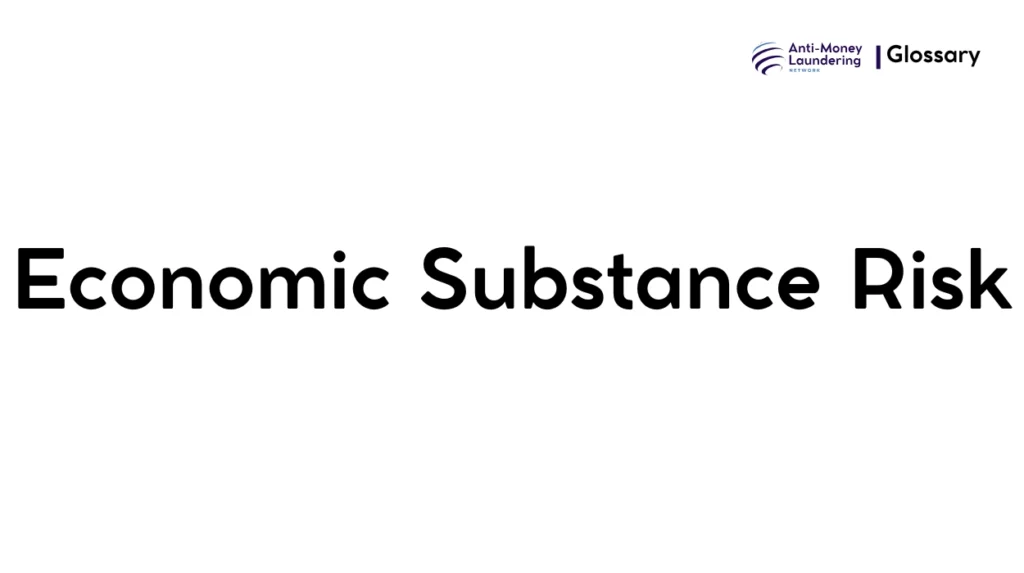Understanding Economic Substance Risk is vital for compliance officers and financial institutions in the fight against money laundering. This comprehensive guide covers its definition, regulatory background, practical applications, requirements, and associated challenges.
Definition
Economic Substance Risk in Anti-Money Laundering (AML) refers to the potential risk that an entity or transaction lacks sufficient genuine economic activity or presence in the jurisdiction where it claims to operate, raising concerns that it could be used as a vehicle for money laundering or tax evasion. This risk emerges when companies or entities exploit jurisdictions without meaningful operations just to disguise the origin of illicit funds or gain unjustified tax benefits.
Purpose and Regulatory Basis
Role in AML
Economic Substance Risk is critical within AML frameworks because entities with no real economic activity in their declared jurisdictions are often vehicles for layering and integrating illicit funds into the financial system. Addressing this risk helps ensure that financial institutions correctly identify and mitigate opportunities for money laundering.
Why It Matters
Without assessing economic substance, financial institutions may fail to detect shell companies or entities established solely for laundering money or hiding proceeds of crime. This undermines AML efforts globally and can expose institutions to regulatory penalties.
Key Regulations
- Financial Action Task Force (FATF) standards emphasize transparency and beneficial ownership verification to combat use of shell companies.
- USA PATRIOT Act provisions call for customer due diligence and risk assessments to identify suspicious activities.
- European Union Anti-Money Laundering Directives (AMLDs) include economic substance considerations as part of risk-based approaches.
- National regimes such as those in Cayman Islands, Bermuda, and other jurisdictions enforce economic substance laws as part of tax and AML compliance frameworks.
When and How it Applies
Real-world Use Cases
- A financial institution onboarding a holding company registered in an offshore jurisdiction must assess whether the entity has real operations, staff, or physical presence.
- Identifying entities involved in relevant activities such as banking, fund management, or intellectual property holding requires verifying substance to rule out risks.
Triggers
- Entities reporting minimal or no local personnel and activities.
- Complex corporate structures crossing multiple jurisdictions without clear business rationale.
- Use of nominee directors or post-box addresses.
Examples
A company claiming to conduct fund management in a jurisdiction but lacking employees, office space, or decision-making there presents an economic substance risk that can indicate a front for laundering.
Types or Variants
Economic substance risk may be classified by the type of activities or sectors involved, including:
- Banking and Finance: Risk where entities profess banking activity but lack operational substance.
- Holding Companies: Risks that arise when holding companies shelter assets without corresponding economic activity.
- Intellectual Property Firms: Entities holding IP rights in low-tax jurisdictions without real R&D activity.
- Shipping or Headquarters Services: Entities asserting operational HQ presence without evidence of management or control.
This helps tailor due diligence and monitoring based on activity-specific risks.
Procedures and Implementation
Steps for Financial Institutions
- Risk Assessment: Identify customers and entities potentially posing economic substance risk during onboarding and periodically.
- Customer Due Diligence (CDD): Collect information on location of management, employees, physical offices, and activities.
- Verification: Use third-party data, onsite visits if necessary, and require documentation evidencing local presence.
- Ongoing Monitoring: Monitor transactions for inconsistencies with declared economic substance.
- Training: Ensure staff understand the concept and recognize red flags linked to economic substance risk.
- Controls: Integrate systems to flag entities lacking economic substance risks for enhanced scrutiny.
Impact on Customers/Clients
Rights and Restrictions
- Customers may need to provide detailed documentation proving genuine business operations.
- Entities failing to demonstrate economic substance may face account restrictions or closure.
Customer Interactions
- Clear communication about economic substance requirements avoids misunderstandings.
- Customers may be asked yearly or periodically to reconfirm their substance status.
Duration, Review, and Resolution
- Economic substance assessments are typically conducted at onboarding and reviewed annually or when significant changes occur.
- Ongoing compliance obligations mean entities must maintain evidence of substance over time.
- Non-compliance can lead to penalties, regulatory reporting, or account termination.
Reporting and Compliance Duties
Institutional Responsibilities
- Maintain documentation of economic substance assessments and findings.
- Report suspicious activities related to fictitious or shell entities.
- Cooperate with regulators during audits or investigations.
Documentation and Penalties
- Failure to adequately assess or document economic substance risks can result in fines and reputational damage.
- Regulators impose sanctions on entities lacking economic substance or institutions failing to comply.
Related AML Terms
- Shell Companies: Entities without real operations increase economic substance risk.
- Beneficial Ownership: Transparency about ultimate owners ties into substance verification.
- Risk-Based Approach: Economic substance risk is a key factor in overall AML risk assessments.
- Enhanced Due Diligence (EDD): Applied where economic substance risk is high.
Challenges and Best Practices
Common Issues
- Difficulty verifying substance in complex international structures.
- Limited access to reliable data across jurisdictions.
- Balancing customer privacy with regulatory transparency requirements.
Best Practices
- Use technology and data analytics to screen and monitor economic substance.
- Regular training and updating of risk controls.
- Collaboration with tax and legal experts to understand jurisdictional nuances.
Recent Developments
- Growing global focus on economic substance due to OECD/G20 initiatives targeting tax avoidance.
- Increasing alignment of substance requirements with AML and tax transparency regulations.
- Use of AI and big data to improve detection of entities lacking economic substance.
Economic Substance Risk is a pivotal consideration in AML compliance, helping institutions identify entities that may be used to launder money under the guise of legitimate business presence. By understanding and managing this risk through robust procedures, financial institutions can uphold global AML standards and mitigate financial and reputational risks.

